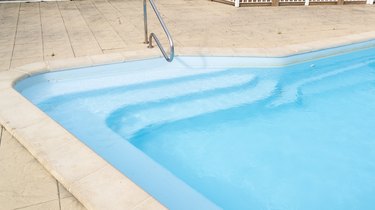
Water behind a pool liner in an in-ground pool can be troublesome if it's not addressed right away. Signs of water behind the pool liner are soft spots that may look and feel like air bubbles; an even worse sign can be a floating pool liner. You will need to determine the cause and then get rid of the water behind the pool liner.
What Causes Water Behind a Pool Liner?
Video of the Day
Water behind a pool liner in an in-ground pool can occur due to a couple of reasons. One reason is groundwater. As spring brings in the rain and winter defrost, the earth around a pool can become saturated if it's not draining properly. Even if this has never happened before, the earth keeps changing, including the earth around your in-ground pool. The other possibility is a leak in the liner, which will need to be repaired.
Video of the Day
Figuring Out Where the Water Is Coming From
Determining where the water behind a pool liner is coming from is imperative. It will require access to the water behind the liner. Once you have a water transfer pump in place and it starts running and removing the water behind the pool liner (see section 4 below), you can test the chlorine levels of the water being pumped using a test strip. The test strip will show the presence of chlorine or not, indicating whether the water is coming from the pool or not. A more accurate way to test if the water is coming from a leak in the pool liner, though, is testing for cyanuric acid.
Why Test for Cyanuric Acid?
Testing for just chlorine may not be the most accurate way to assess the source of the water behind a pool liner due to how quickly chlorine evaporates. Cyanuric acid is the chemical in pool water that stabilizes the chlorine and does not easily evaporate from the water like chlorine does.
To test for cyanuric acid, you will need a pool water test kit that specifically tests for cyanuric acid. As a pool owner, you may want to consider having this kit around anyway to help maintain the pool water more effectively. Follow the instructions specific for your test kit and test the water behind the pool liner.
Tip
Using hot water will help make the pool liner more pliable and easier to work with.
Getting Rid of the Water
To get rid of the water behind an in-ground pool liner, you will need a few plumbing skills as well as some patience. It may also require a trip to the hardware store to get a few things, such as a water transfer pump, one short hose (12 feet or so), and one long hose (long enough to discharge water safely away from the pool area). Gain access to the backside of the pool liner by removing the liner from about 6 to 18 inches of the coping track. Carefully slide the short hose behind the liner and attach it to the water transfer pump. Attach the longer hose to the outlet side of the water transfer pump and navigate the hose to a location that's a safe distance from the pool area.
Some water transfer pumps need to be primed, or filled with water, before starting to pump. Follow the directions for your specific pump and prime the pump if necessary. Turn the pump on until it stops pumping water. Use a test strip or pool water kit to check the water being discharged for chlorine or better, cyanuric acid, to determine if the water behind the pool liner is from a leak in the liner.
Replacing the Liner in Its Coping Track
Once you are satisfied that the water has been removed from behind the pool liner, it is time to place the liner back into the coping track. This is best done on a warm day if possible, but a bucket of hot water can help. Work the liner back into the track using hot water, if necessary, to help keep the liner pliable. Lock in the pool liner using a pool liner locking system once the liner is back in the track.